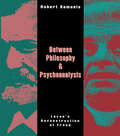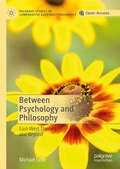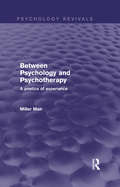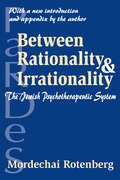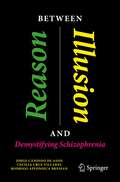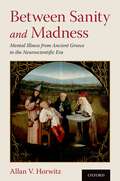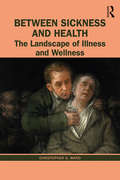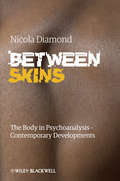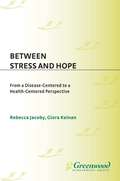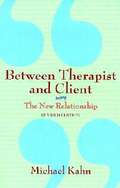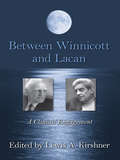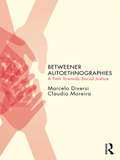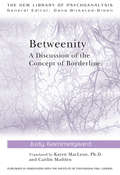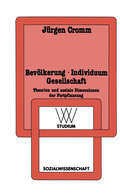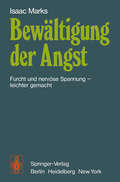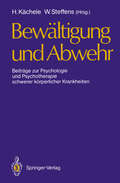- Table View
- List View
Between Philosophy and Psychoanalysis: Lacan's Reconstruction of Freud
by Robert SamuelsFirst published in 1993. Routledge is an imprint of Taylor & Francis, an informa company.
Between Psychology and Philosophy: East-West Themes and Beyond (Palgrave Studies in Comparative East-West Philosophy)
by Michael SloteThis open access book discusses a variety of important but unprecedented ways in which psychology can be useful to philosophy. The early chapters illustrate this theme via comparisons between Chinese and Western philosophy. It is argued that the Chinese notion of a heart-mind is superior to the Western concept of mind, but then, more even-handedly, the relative strengths and weaknesses of Chinese and Western thought overall are critically examined. In later chapters, the philosophical uses of psychology are treated more specifically in relation to major issues in Western philosophy. Michael Slote shows that empathy and emotion play a role in speech acts (like assertion and thanking) that speech act theory has totally ignored. Similarly, he treats the age-old question of whether justice pays using psychological material that has not previously been recognized. Finally, the implications of psychological egoism are discussed in terms of some new psychological and, indeed, human distinctions. Human life is pervaded by instincts and aspirations that are neither egoistic nor altruistic, and recognizing that fact can help put egoism in its place. It is less of a challenge to morality than we have realized.
Between Psychology And Psychotherapy: A Poetics Of Experience (PDF)
by Miller MairIn this highly original and thought-provoking work the late Miller Mair puts forward his ideas for a new psychology. First published in 1989, he deals with issues of fundamental importance to the future of a psychology guided by genuine enquiry and concern rather than mere professional self-interest. Crossing and re-crossing boundaries between psychology, psychotherapy and philosophy, and between ‘science’ and ‘art’, he demonstrates the linkages between the personal and the impersonal, subject and object, inside and outside, with a daring not previously risked by anyone working in the area. Dr Mair stresses the importance of a poetic approach in psychology and psychotherapy, and the need to explore and understand the nature of psychology through an imaginative freedom of language. He emphasizes that a poetic awareness and attentiveness is fundamental to any pursuit of understanding of ourselves or others. This is a very personal book, concerned with personal knowledge, but it is meant for anyone who seeks to understand themselves and others, and what is involved in coming to such understanding. Focusing on ordinary human experience, and moving towards literary and artistic modes of expression, the author invites you to enter in, follow what you think and feel, as he proposes a radical revision of much that is accepted in psychology and in psychotherapy.
Between Psychology And Psychotherapy: A Poetics Of Experience
by Miller MairIn this highly original and thought-provoking work the late Miller Mair puts forward his ideas for a new psychology. First published in 1989, he deals with issues of fundamental importance to the future of a psychology guided by genuine enquiry and concern rather than mere professional self-interest. Crossing and re-crossing boundaries between psychology, psychotherapy and philosophy, and between ‘science’ and ‘art’, he demonstrates the linkages between the personal and the impersonal, subject and object, inside and outside, with a daring not previously risked by anyone working in the area. Dr Mair stresses the importance of a poetic approach in psychology and psychotherapy, and the need to explore and understand the nature of psychology through an imaginative freedom of language. He emphasizes that a poetic awareness and attentiveness is fundamental to any pursuit of understanding of ourselves or others. This is a very personal book, concerned with personal knowledge, but it is meant for anyone who seeks to understand themselves and others, and what is involved in coming to such understanding. Focusing on ordinary human experience, and moving towards literary and artistic modes of expression, the author invites you to enter in, follow what you think and feel, as he proposes a radical revision of much that is accepted in psychology and in psychotherapy.
Between Rationality and Irrationality: The Jewish Psychotherapeutic System
by Mordechai RotenbergJewish Scriptural interpretation entails a potential therapeutic bridge between the rational-material and the irrational-mystic in the world of psychotherapy. PaRDeS, as this system is known, is derived from the following concepts. "P" denotes peshat, the plain interpretation of the text, which translates into a rational interpretation of life. "R" symbolizes remez, hinting at a related religious concept, which becomes a symbolic view of life. "D" stands for derash, the homiletic way of interpreting a text, or a narrative reading of life. And "S" represents sod, or the mystery behind an idea, which in psychological terms becomes a mystic understanding of life. Mordechai Rotenberg believes that it is by engaging readings in a "dialogue" with each other, as in the Jewish hermeneutic tradition, the psychology underlying one's existence may be more readily understood. While Rotenberg acknowledges that it is legitimate to focus on one cognitive-rational or one narrative-storytelling therapeutic method in the course of therapy, he argues that a comprehensive theory of psychotherapy should include treatment possibilities for both rational and irrational manifestations of behavior, thereby engulfing all aspects of human behavior. For Rotenberg, a person's life becomes the "text," subject to being read and interpreted. If that person wishes to change his or her behavior via psychotherapy, then a hermeneutic system must be employed to understand that person's life. However, many systems interpret a person's life according to the particular theory espoused by the therapist. Rotenberg, in contrast, introduces a balanced theory bridging the rational and the irrational.Between Rationality and Irrationality emphasizes that it is more important for a therapist to learn his client's own "language" than to impose his own doctrinaire interpretation. This edition includes a new introduction by the author, as well as an appendix explicating an original psychological interpretation of PaRDeS
Between Rationality and Irrationality: The Jewish Psychotherapeutic System
by Mordechai RotenbergJewish Scriptural interpretation entails a potential therapeutic bridge between the rational-material and the irrational-mystic in the world of psychotherapy. PaRDeS, as this system is known, is derived from the following concepts. "P" denotes peshat, the plain interpretation of the text, which translates into a rational interpretation of life. "R" symbolizes remez, hinting at a related religious concept, which becomes a symbolic view of life. "D" stands for derash, the homiletic way of interpreting a text, or a narrative reading of life. And "S" represents sod, or the mystery behind an idea, which in psychological terms becomes a mystic understanding of life. Mordechai Rotenberg believes that it is by engaging readings in a "dialogue" with each other, as in the Jewish hermeneutic tradition, the psychology underlying one's existence may be more readily understood. While Rotenberg acknowledges that it is legitimate to focus on one cognitive-rational or one narrative-storytelling therapeutic method in the course of therapy, he argues that a comprehensive theory of psychotherapy should include treatment possibilities for both rational and irrational manifestations of behavior, thereby engulfing all aspects of human behavior. For Rotenberg, a person's life becomes the "text," subject to being read and interpreted. If that person wishes to change his or her behavior via psychotherapy, then a hermeneutic system must be employed to understand that person's life. However, many systems interpret a person's life according to the particular theory espoused by the therapist. Rotenberg, in contrast, introduces a balanced theory bridging the rational and the irrational.Between Rationality and Irrationality emphasizes that it is more important for a therapist to learn his client's own "language" than to impose his own doctrinaire interpretation. This edition includes a new introduction by the author, as well as an appendix explicating an original psychological interpretation of PaRDeS
Between Reason and Illusion: Demystifying Schizophrenia (Copernicus Books)
by Jorge Cândido Assis Cecília Cruz Villares Rodrigo Affonseca BressanThis book realistically describes the experiences of people living with schizophrenia and their families, from the detection of the first symptoms until the development of treatments and strategies to cope with this unique human condition. Schizophrenia is a form of psychosis in which subjective aspects, such as hallucinatory and delusional phenomena, tend to distort the understanding of reality. Because psychotic states fluctuate in intensity over time, those affected literally live between reason and illusion. Between Reason and Illusion: Demystifying Schizophrenia is an invitation to understand what it means to develop schizophrenia and to live with it throughout one's life. And this is an invitation to all those who are in some way affected by this condition: those who live with it, family members, friends, health professionals, and everyone who want to have a non-stigmatized view of mental disorders and people who live with them. “Faced with psychosis, the person affected by the disease and the family are lost and go looking for alternative or spiritual help, which usually delays the beginning of treatment. Jorge, Cecília and Rodrigo had the courage to face a difficult theme and the happy idea of writing a book of an educational nature about schizophrenia. The book's originality lies in the fact that it was written taking into account the experience of the person with the disease and his or her family members in the face of this something new that has occurred in their lives”. - Dr. Itiro Shirakawa, Professor Emeritus of the Paulista Medical School of the Federal University of São Paulo (UNIFESP/EPM), Brazil.
Between Sanity and Madness: Mental Illness from Ancient Greece to the Neuroscientific Era
by Allan V. HorwitzBetween Sanity and Madness: Mental Illness from Ancient Greece to the Neuroscientific Era examines several perennial issues about mental illness: how different societies have distinguished mental disorders from normality; whether mental illnesses are similar to or different from organic conditions; and the ways in which different eras conceive of the causes of mental disorder. It begins with the earliest depictions of mental illness in Ancient Greek literature, philosophy, and medicine and concludes with the portrayals found in modern neuroscience. In contrast to the tremendous advances other branches of medicine display in answering questions about the nature, causes, and treatments of physical diseases, current psychiatric knowledge about what qualities of madness distinguish it from sanity, the resemblance of mental and physical pathologies, and the kinds of factors that lead people to become mentally ill does not show any steady growth or, arguably, much progress. The immense recent technological advances in brain science have not yet led to corresponding improvements in understandings of and explanations for mental illnesses. These perplexing phenomena remain almost as mysterious now as they were millennia ago.
Between Sanity and Madness: Mental Illness from Ancient Greece to the Neuroscientific Era
by Allan V. HorwitzBetween Sanity and Madness: Mental Illness from Ancient Greece to the Neuroscientific Era examines several perennial issues about mental illness: how different societies have distinguished mental disorders from normality; whether mental illnesses are similar to or different from organic conditions; and the ways in which different eras conceive of the causes of mental disorder. It begins with the earliest depictions of mental illness in Ancient Greek literature, philosophy, and medicine and concludes with the portrayals found in modern neuroscience. In contrast to the tremendous advances other branches of medicine display in answering questions about the nature, causes, and treatments of physical diseases, current psychiatric knowledge about what qualities of madness distinguish it from sanity, the resemblance of mental and physical pathologies, and the kinds of factors that lead people to become mentally ill does not show any steady growth or, arguably, much progress. The immense recent technological advances in brain science have not yet led to corresponding improvements in understandings of and explanations for mental illnesses. These perplexing phenomena remain almost as mysterious now as they were millennia ago.
Between Sickness and Health: The Landscape of Illness and Wellness
by Christopher D. WardBetween Sickness and Health is about illness rather than disease, and recovery rather than cure. The book argues that illness is an experience, represented by the feeling that ‘I am not myself’. From the book’s phenomenological point of view, feelings of illness cannot be ‘unreal’ or ‘fake’, whatever their biological basis, nor need they be categorised as ‘physical’, ‘psychosomatic’ or ‘psychiatric’. The book challenges the disease-centred ethos of medicine and medical education. It demonstrates that a clearer conception of illness, as distinct from disease, is therapeutic. The feeling that ‘I am once again myself’ can return, in some degree, whatever state the body is in. Resilience becomes more available when it is seen as a set of personal skills that can be developed, rather than as an inborn trait. Possibilities of wellness are enhanced by recognising that medical and other therapies can either support or impede recovery, as can human relationships and the socio-political environment. The book’s many clinical examples are drawn from the author’s broad experience as a neurologist, rehabilitation physician and systemic family therapist. Between Sickness and Health will be useful for students, practitioners and academics, and also for anyone who has been or might one day be ill.
Between Sickness and Health: The Landscape of Illness and Wellness
by Christopher D. WardBetween Sickness and Health is about illness rather than disease, and recovery rather than cure. The book argues that illness is an experience, represented by the feeling that ‘I am not myself’. From the book’s phenomenological point of view, feelings of illness cannot be ‘unreal’ or ‘fake’, whatever their biological basis, nor need they be categorised as ‘physical’, ‘psychosomatic’ or ‘psychiatric’. The book challenges the disease-centred ethos of medicine and medical education. It demonstrates that a clearer conception of illness, as distinct from disease, is therapeutic. The feeling that ‘I am once again myself’ can return, in some degree, whatever state the body is in. Resilience becomes more available when it is seen as a set of personal skills that can be developed, rather than as an inborn trait. Possibilities of wellness are enhanced by recognising that medical and other therapies can either support or impede recovery, as can human relationships and the socio-political environment. The book’s many clinical examples are drawn from the author’s broad experience as a neurologist, rehabilitation physician and systemic family therapist. Between Sickness and Health will be useful for students, practitioners and academics, and also for anyone who has been or might one day be ill.
Between Skins: The Body in Psychoanalysis - Contemporary Developments
by Nicola DiamondBetween Skins challenges individualistic accounts of the body in psychoanalysis. Drawing on philosophy, contemporary neurobiology and developmental research, Nicola Diamond explores the ways in which bodily processes and skin experience are inseparable from the field of language and environmental context. The first book to address epistemological implications for a new understanding of the body and embodiment - offers a new perspective on the division between mind, body and world Brings together a philosophical phenomenological account of body experience with key concepts from psychoanalysis, developmental research and neuroscience Responds to a growing interest in the body and psychoanalysis, and considers some limitations in neuro-biological accounts of brain-body processes for psychoanalytical understanding
Between Skins: The Body in Psychoanalysis - Contemporary Developments
by Nicola DiamondBetween Skins challenges individualistic accounts of the body in psychoanalysis. Drawing on philosophy, contemporary neurobiology and developmental research, Nicola Diamond explores the ways in which bodily processes and skin experience are inseparable from the field of language and environmental context. The first book to address epistemological implications for a new understanding of the body and embodiment - offers a new perspective on the division between mind, body and world Brings together a philosophical phenomenological account of body experience with key concepts from psychoanalysis, developmental research and neuroscience Responds to a growing interest in the body and psychoanalysis, and considers some limitations in neuro-biological accounts of brain-body processes for psychoanalytical understanding
Between Stress and Hope: From a Disease-Centered to a Health-Centered Perspective (Praeger Series in Health Psychology)
by Rebecca Jacoby Giora KeinanThis volume focuses on the concepts of stress and hope, their psychological and physical outcomes. Past research has focused primarily or exclusively on either stress or hope and its effect on health. This work discusses them side by side and highlights their interrelations. Various theoretical approaches dealing with stress and hope are discussed, and a review of the most recent empirical data is presented. Also included are reports on individuals and groups that have been exposed to various stressful situations, such as racial prejudice, life threatening illness, or imprisonment. The role of hope in coping with these sitatuions is emphasized.Contributors to this edited collection are at the cutting edge of theory and research in the fields of stress and hope. Students and scholars studying health psychology, stress management or stress and coping will appreciate the information presented, as will those involved with medical science, nursing, and sociology.
Between Therapist and Client: The New Relationship (PDF)
by Michael KahnIn "Between Therapist and Client, " Michael Kahn explores what is perhaps the most important aspect of therapy - the therapist-client relationship. As he traces the history of the clinical relationship from Freud to the present, Kahn shows how the enmity between the humanists and the psychoanalysts limited their therapeutic effectiveness - and how their recent reconciliation has opened up exciting new possibilities for the way therapists relate to clients, pointing to a promising new period in the history of psychotherapy.
Between Therapist And Client: The New Relationship
by Michael Kahn Michael K. KahnPerhaps the most important aspect of the therapeutic process is the relationship between therapist and client. For years, two major schools of thought have strongly disagreed about what the nature of that relationship should be. The humanists emphasized warmth and empathy. The psychoanalysts kept a neutral, cool distance. Recently, however, the beginnings of a reconciliation between these traditions have opened new possibilities for the way therapists relate to clients. InBetween Therapist and Client, Michael Kahn shows why this new consensus is promising. Beginning with Freud's discovery of transference, Kahn traces the history of the clinical relationship from Carl Rogers' introduction of humanistic concerns through Merton Gill's theory and technique of transference analysis, to the pioneering work of Heinz Kohut, who has most successfully brought together psychoanalytic and humanistic thought. Using vivid examples from his own practice, Kahn shows how a coherent synthesis of these various approaches leads to the most successful clinical relationships. Completely updated with greater discussion of ethics and countertransference, the new edition ofBetween Therapist and Client is essential reading for those in psychotherapy both therapist and client.
Between Winnicott and Lacan: A Clinical Engagement
by Lewis A. KirshnerD. W. Winnicott and Jacques Lacan, two of the most innovative and important psychoanalytic theorists since Freud, are also seemingly the most incompatible. And yet, in different ways, both men emphasized the psychic process of becoming a subject or of developing a separate self, and both believed in the possibility of a creative reworking or new beginning for the person seeking psychoanalytic help. The possibility of working between their contrasting perspectives on a central issue for psychoanalysis - the nature of the human subject and how it can be approached in analytic work - is explored in this book. Their differences are critically evaluated, with an eye toward constructing a more effective psychoanalytic practice that takes both relational and structural-linguistic aspects of subjectivity into account. The contributors address the Winnicott-Lacan relationship itself and the evolution of their ideas, and provide detailed examples of how they have been utilized in psychoanalytic work with patients. Contributors: Jeanne Wolff Bernstein, James Gorney, Andre Green, Mardi Ireland, Lewis Kirshner, Deborah Luepnitz, Mari Ruti, Alain Vanier, Francois Villa .
Between Winnicott and Lacan: A Clinical Engagement
by Lewis A. KirshnerD. W. Winnicott and Jacques Lacan, two of the most innovative and important psychoanalytic theorists since Freud, are also seemingly the most incompatible. And yet, in different ways, both men emphasized the psychic process of becoming a subject or of developing a separate self, and both believed in the possibility of a creative reworking or new beginning for the person seeking psychoanalytic help. The possibility of working between their contrasting perspectives on a central issue for psychoanalysis - the nature of the human subject and how it can be approached in analytic work - is explored in this book. Their differences are critically evaluated, with an eye toward constructing a more effective psychoanalytic practice that takes both relational and structural-linguistic aspects of subjectivity into account. The contributors address the Winnicott-Lacan relationship itself and the evolution of their ideas, and provide detailed examples of how they have been utilized in psychoanalytic work with patients. Contributors: Jeanne Wolff Bernstein, James Gorney, Andre Green, Mardi Ireland, Lewis Kirshner, Deborah Luepnitz, Mari Ruti, Alain Vanier, Francois Villa .
Betweener Autoethnographies: A Path Towards Social Justice (Qualitative Inquiry and Social Justice)
by Marcelo Diversi Claudio MoreiraHow do we persuade people that we all have common experiences and hopes? That we are ever more dependent on each other in times of globalization via technology, commerce, climate change, and overpopulation? How do we move from an "Us and Them" mentality to simply "Us"? In this book, a follow-up to their first book Betweener Talk, the authors share autoethnographies about being and doing scholarship as betweeners searching for inclusivity. The authors have witnessed an escalation of division in their native Brazil and in the USA, as well as in South America more broadly and Europe – places that had been making steady, albeit slow, progress toward greater inclusion. The book explores identity, interactions, existence, and possibilities in the spaces between "Us" and "Them" to help current and future generations imagine a more inclusive way of living – as Us. It is about how two Third World scholars think the Postcolonial/Decolonizing discourse – with a performance studies lens – can further notions of inclusive social justice through scholarship borne out of lived oppression and the struggle for humanization. It is a union of two authors who, in their own words "have been close friends since our youth, both captivated by Paulo Freire’s notion of education and social transformation through a praxis of conscientização (conscientization), but who experienced life growing up at opposite ends of the social class spectrum. Early through love and later through theory, we have come to viscerally inhabit and embrace our betweener identities in scholarship and daily lives, breaking the distance between us and the paradigms that attempt to separate political, personal, and professional life." The authors’ hope is that their own and other betweener autoethnographies can contribute to the larger qualitative inquiry global movement and its central goal: marching together toward ever greater social justice.
Betweener Autoethnographies: A Path Towards Social Justice (Qualitative Inquiry and Social Justice)
by Marcelo Diversi Claudio MoreiraHow do we persuade people that we all have common experiences and hopes? That we are ever more dependent on each other in times of globalization via technology, commerce, climate change, and overpopulation? How do we move from an "Us and Them" mentality to simply "Us"? In this book, a follow-up to their first book Betweener Talk, the authors share autoethnographies about being and doing scholarship as betweeners searching for inclusivity. The authors have witnessed an escalation of division in their native Brazil and in the USA, as well as in South America more broadly and Europe – places that had been making steady, albeit slow, progress toward greater inclusion. The book explores identity, interactions, existence, and possibilities in the spaces between "Us" and "Them" to help current and future generations imagine a more inclusive way of living – as Us. It is about how two Third World scholars think the Postcolonial/Decolonizing discourse – with a performance studies lens – can further notions of inclusive social justice through scholarship borne out of lived oppression and the struggle for humanization. It is a union of two authors who, in their own words "have been close friends since our youth, both captivated by Paulo Freire’s notion of education and social transformation through a praxis of conscientização (conscientization), but who experienced life growing up at opposite ends of the social class spectrum. Early through love and later through theory, we have come to viscerally inhabit and embrace our betweener identities in scholarship and daily lives, breaking the distance between us and the paradigms that attempt to separate political, personal, and professional life." The authors’ hope is that their own and other betweener autoethnographies can contribute to the larger qualitative inquiry global movement and its central goal: marching together toward ever greater social justice.
Betweenity: A Discussion of the Concept of Borderline (The New Library of Psychoanalysis)
by Judy GammelgaardFrom its inception psychoanalysis has sought to effect a cure through the therapeutic relationship between analyst and analysand. Betweenity looks at what happens when the established framework of the psychoanalytic process is challenged by those with borderline personalities. In this book Judy Gammelgaard looks at how we might understand the analysand who is unable to engage with therapy and how we might bring them to a point where they are able to do so. Areas of discussion include: the border between psychiatry and psychoanalysis early mother-child relationships the splitting of the ego. This book will be essential reading for all psychoanalysts, psychotherapists and practitioners wishing to learn more about working with borderline personality structures and disorders.
Betweenity: A Discussion of the Concept of Borderline (The New Library of Psychoanalysis)
by Judy GammelgaardFrom its inception psychoanalysis has sought to effect a cure through the therapeutic relationship between analyst and analysand. Betweenity looks at what happens when the established framework of the psychoanalytic process is challenged by those with borderline personalities. In this book Judy Gammelgaard looks at how we might understand the analysand who is unable to engage with therapy and how we might bring them to a point where they are able to do so. Areas of discussion include: the border between psychiatry and psychoanalysis early mother-child relationships the splitting of the ego. This book will be essential reading for all psychoanalysts, psychotherapists and practitioners wishing to learn more about working with borderline personality structures and disorders.
Bevölkerung · Individuum Gesellschaft: Theorien und soziale Dimensionen der Fortpflanzung (wv studium)
by Jürgen CrommAusgehend von einer anthropologischen Betrachtung und der Herausarbeitung des sozial Wesentlichen menschlicher Fortpflanzung und nach systematischer Begriffsentwicklung (Verhalten, generatives Handeln, Motivation u.a.) werden Bestimmungsgründe der Fortpflanzung behandelt. Bevölkerungspolitik und geburtenregelndes Handeln runden den ersten Teil ab.Der zweite Teil beschreibt und erörtert in einem ideengeschichtlichen Abriß die wichtigsten Stationen der Deutung und Erklärung des Bevölkerungs-, vor allem des Fortpflanzungsgeschehens und liefert anschließend einen Querschnitt neuerer Theorien, Ansätze, Modelle in der Ökonomie, Soziologie und Psychologie.
